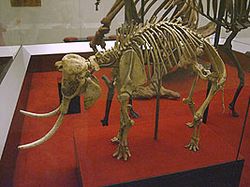Dwarf elephant facts for kids
Quick facts for kids Dwarf elephantsTemporal range: Pleistocene
|
|
|---|---|
 |
|
| Skeleton of a Cretan Dwarf elephant. | |
| Scientific classification | |
| Kingdom: | |
| Phylum: | |
| Class: | |
| Order: |
Proboscidea
in part |
Dwarf elephants were amazing prehistoric elephants. They lived a long, long time ago during the Pleistocene period. This was an ice age time, ending about 11,700 years ago.
These elephants were much smaller than their relatives on the mainland. They are a great example of something called island dwarfism. This is when large animals become smaller over many generations. It happens when they live on islands with limited food and space.
Contents
Understanding Island Dwarfism
When large animals like elephants move to islands, things change. Islands often have less food than big continents. They also have fewer predators.
Because of this, being smaller can be a big advantage. Smaller bodies need less food to survive. Over thousands of years, the biggest elephants might not do as well. The smaller ones thrive and pass on their genes. This leads to a new, smaller type of elephant. It's a cool way nature adapts!
Where Did These Tiny Giants Live?
Scientists have found fossils of dwarf elephants in many places. Most of these places are islands.
Mediterranean Islands
Many dwarf elephant bones have been found around the Mediterranean Sea. These islands include:
Other Island Homes
Dwarf elephants also lived on islands far from the Mediterranean. Fossils show they were on:
- Sulawesi
- Flores
- Timor
- Other islands in the Lesser Sundas group
- The Channel Islands off the coast of California
Their Family Tree: Related to Mammoths?
It might surprise you, but some dwarf elephants were related to mammoths! Specifically, some of the dwarf elephants found on Mediterranean islands are thought to be part of the mammoth family line.
This means that huge mammoths, over many generations, became tiny elephants. It's a fantastic example of how animals can change over time.
Why Did They Disappear?
Like many prehistoric animals, dwarf elephants eventually died out. This is called extinction. The reasons for their disappearance are still being studied.
It could have been changes in climate or sea levels. When sea levels rose, islands might have shrunk. This would have reduced their living space and food even more. Humans arriving on these islands might also have played a role.
Images for kids
-
Detail of a painting in the Ancient Egyptian tomb of Rekhmire (c. 1470-1445 BCE), possibly representing a dwarf elephant (lower left) and brown bear among presents brought by ancient Syrians.





